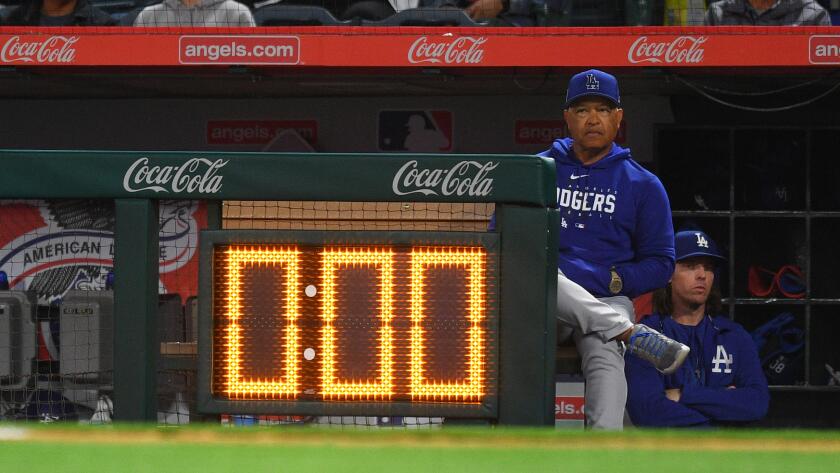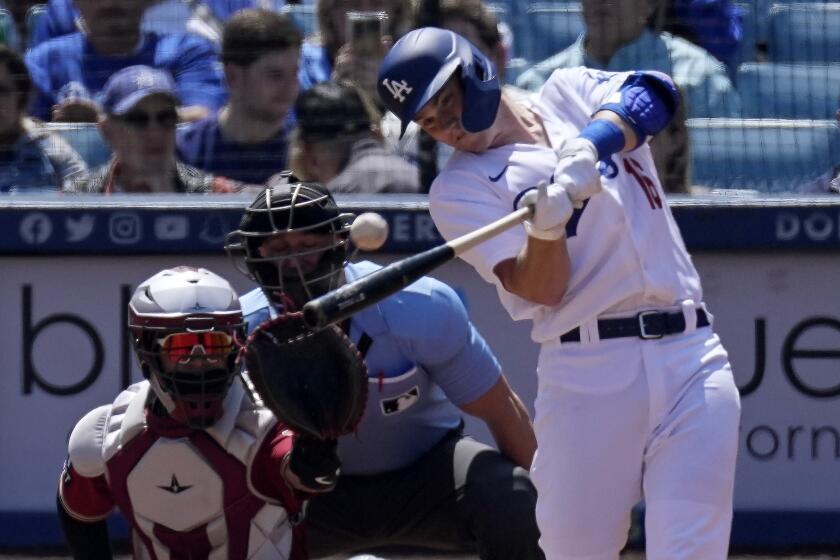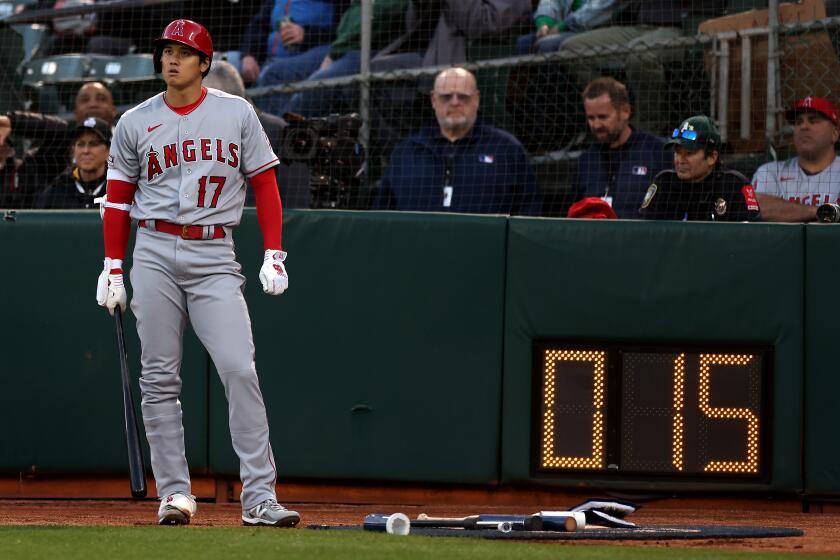MLB pitch clock proving to be a mental and physical game-changer
- Share via
- Share via
It was the third inning Saturday and Clayton Kershaw needed a moment to collect himself.
The Dodgers were already leading the Arizona Diamondbacks 5-1. But Gabriel Moreno led the inning off for Arizona with a double before taking third base on a flyball to center field. It was a potential game-changing spot. Kershaw knew what he wanted.
“I was like, ‘All right, we need a strikeout here,’ ” Kershaw recalled from the home dugout at Dodger Stadium on Tuesday.
Various unintended consequences of the pitch clock have surfaced over the first week of the major league baseball season. Everyone at ballparks across the country have been affected — from players and coaches to fans and broadcasters. Some differences are obvious, others are not.
One, momentum within an inning, subtly surfaced for Kershaw on Saturday.
Will Smith is off to a fantastic start for the Dodgers. While the catcher might come across as boring, his skill and loyalty have him on a path to stardom.
In his first 15 seasons with the Dodgers, Kershaw could have bided his time to prepare for the next encounter with Moreno at third. He could have stalled to analyze the situation, to ponder how to attack Kyle Lewis, just by walking around the mound a bit. But that isn’t a luxury this season. Not with the pitch clock ticking.
“So I called Barnesy out just to take a minute to think about it,” Kershaw said.
Barnesy is Kershaw’s longtime trusted catcher, Austin Barnes. The filibustering, formally one of the Dodgers’ allotted five mound visits for the game, proved effective. Kershaw struck out Lewis and Ketel Marte each with four pitches, finishing both at-bats with curveballs out of the strike zone, to flatten the threat.
“I think your ability to slow games down, knowing what you want to do is important because you have to get going with it,” Barnes said as he snapped his fingers. “It’s quick. The game’s fast and you need to be thinking ahead about this pitch and that pitch.”

Kershaw, 35, held the Diamondbacks to one run with nine strikeouts and no walks over six innings in a 10-1 win that went 2 hours and 14 minutes. Christian Walker’s leadoff home run in the second frame was the lone costly blip. The third inning was the only time Arizona put a runner in scoring position. Kershaw said it was an example of momentum in the nascent Pitch Clock Era.
“If you’re in a good groove, you don’t really notice it, but I think there are going to be times where, with the stress of innings and people on base, you gotta make big pitches and you might feel a little rushed,” said Kershaw, who believes the pitch clock is good addition for the sport. “So you just got to use those mound visits when you can.”
Earl Weaver famously summarized day-to-day momentum in baseball. “Momentum is only as good as tomorrow’s starting pitcher,” the adage goes. But momentum has always existed within games. The pitch clock, at least anecdotally, has escalated the possibility for drastic shifts within innings.
Pitchers now have 15 seconds to begin their motion with the bases empty and 20 seconds with a runner on base. A violation produces an automatic ball. The change has been an unbridled success. Quickening the pace cut game times through Tuesday by an average of 28 minutes compared to the average game time last season. The snappier speed also means the chances of an inning spiraling out of control are higher.
- Share via
Dodgers fans share their opinions on the pitch clock and whether it makes the game better or not.
One potential example: The Philadelphia Phillies gave up nine runs in the fourth inning against the Texas Rangers on opening day. After the game, Phillies ace Aaron Nola, who was pulled after surrendering five runs in the frame, told reporters the pitch clock remains a challenge. Phillies catcher J.T. Realmuto told the Athletic he was out of breath behind the plate.
“With the pitch clock, you can’t ever slow the pitcher down,” Realmuto said. “It’s crazy. Once an offense gets rolling and the pitcher gets on the ropes a little bit, it’s really hard.”
The Phillies pitching coach made one mound visit early in the inning. By rule, the pitcher must be removed during the second visit. The pause didn’t stymie the Rangers.
In Los Angeles, Walker, the Diamondbacks’ slugging first baseman, noted he felt momentum swings more acutely in Arizona’s 8-2 loss to the Dodgers to open the season.
“I think, no matter what side of the momentum you’re on, harnessing that is going to be a challenge,” Walker said. “When you’re behind and you feel like you’re looking to slow things down, trying to find a way to combat the clock, I think is going to be another challenge.”
The pitch clock is winning over players and fans while it’s making baseball more fun and exciting. MLB might have saved itself with the concept.
On Monday, the Dodgers exploded for seven two-out runs in the fifth inning of their 13-4 win over the Colorado Rockies. The onslaught began with Freddie Freeman lining a double against Rockies starter Ryan Feltner. It ended with a groundout from Chris Taylor. In between, the Rockies made three mound visits and a pitching change.
“You can’t get a 20-second timeout [whenever you want],” Dodgers manager Dave Roberts said. “So you got to sort of hang in there and bow your neck and keep making pitches so you can’t really stop the momentum. It’s a lot harder.”
That wasn’t lost on Kershaw when he called Barnes out Saturday. Working with the pitch clock in a game that mattered for the first time, Kershaw recognized he needed more time to execute pitches in the third inning. It may have been the difference in his outing.
“There’s no way to prepare for it,” Kershaw said. “Hopefully, you don’t have any of those situations, but it’s inevitable.”
More to Read
Are you a true-blue fan?
Get our Dodgers Dugout newsletter for insights, news and much more.
You may occasionally receive promotional content from the Los Angeles Times.













